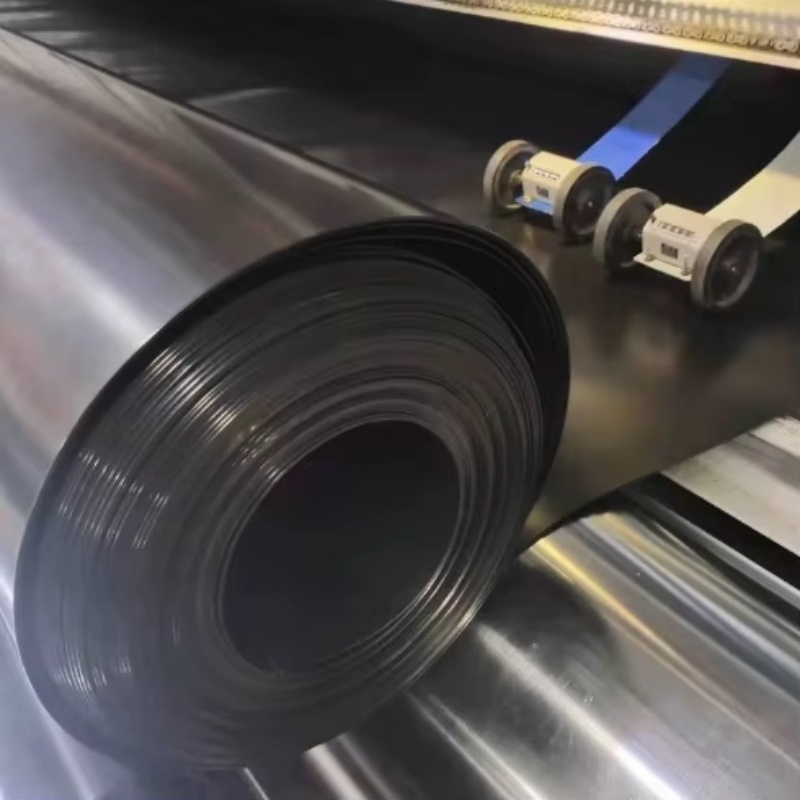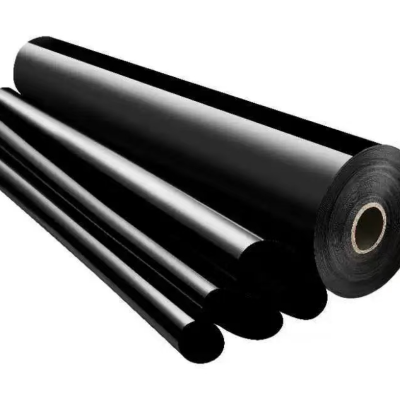1mm Aquaculture Pond Liner
1. Excellent water retention performance, capable of firmly holding water bodies, reducing leakage, lowering water replenishment costs, and maintaining stable breeding environment.
2. Appropriate thickness for aquatic scenarios, with good flexibility, easy to fit the contour of the pool, convenient for construction and high efficiency.
3. Resistant to acid and alkali, corrosion-resistant, able to withstand the erosion of chemical substances in the breeding water, and extending service life.
4. Smooth surface reduces the attachment of silt, facilitating cleaning and maintenance, and reducing the daily maintenance workload.
5. Safe and non-toxic material, does not pollute the water body and the breeding species, ensuring product quality and breeding safety.
Chapter 1: Composition of the Geomembrane
The 1mm aquaculture pond geomembrane is primarily composed of 92% high-density polyethylene (HDPE), a robust polymer that delivers core structural integrity. It also contains 5% anti-UV masterbatch to resist sunlight-induced aging and 3% composite additives—including antioxidants and lubricants. The antioxidants slow material degradation, while lubricants enhance processability during production. This formula ensures the geomembrane balances durability and adaptability for aquaculture use.
Chapter 2: Physical Properties of the Geomembrane
The 1mm geomembrane boasts physical properties ideal for aquaculture. It has uniform thickness (tolerance ±0.05mm) for consistent performance, high tensile strength to withstand installation stress, and excellent flexibility to fit pond contours. Its low water permeability prevents seepage, and the smooth surface minimizes sediment buildup, reducing maintenance needs.
Chapter 3: Chemical Properties of the Geomembrane
The 1mm geomembrane exhibits strong chemical stability in aquaculture environments. It resists corrosion from ammonia, nitrates, and weak acids/bases common in fish ponds, avoiding material breakdown. It is non-toxic, posing no harm to aquatic life, and does not leach harmful substances. Additionally, it withstands microbial growth, maintaining integrity in moist conditions.
Chapter 4: Application Areas
1.Freshwater Fish Farming: Lined in tilapia, catfish, and carp ponds. It prevents water seepage, cutting water replenishment costs by 60% and maintaining stable water quality, which boosts fish survival rates by 15-20%.
2.Shrimp and Crab Aquaculture: Used in high-density shrimp ponds. It isolates soil contaminants, reduces pathogen exposure, and simplifies bottom cleaning, increasing shrimp yields by 25%.
3.Aquaculture Wastewater Storage: Lined in wastewater tanks to prevent harmful substances (e.g., excess feed residues) from seeping into groundwater, meeting environmental regulations.
4.Freshwater Reservoirs for Aquaculture: Applied in small reservoirs that supply water to fish ponds. It reduces water loss via seepage, ensuring consistent water supply during dry seasons.
5.Recirculating Aquaculture Systems (RAS): Integrated into RAS to line culture tanks. Its smooth surface minimizes biofilm buildup, reducing water treatment costs and improving system efficiency.
Chapter 5: Installation Steps of the Geomembrane
1.Site Preparation: Clear the pond area of stones, roots, and sharp debris to avoid puncturing the membrane. Level the ground (slope ≤1:4) and compact the soil to a density of ≥1.6g/cm³ for a stable base.
2.Membrane Unfolding: Unroll the geomembrane along the pond’s length, keeping it slightly loose (5-10cm slack per 10m) to accommodate thermal expansion. Align adjacent rolls with a 12-15cm overlap.
3.Seaming: Use hot wedge welding with a temperature of 190-210℃ and speed of 1.8-2.2m/min. After welding, conduct a vacuum test (negative pressure ≥28kPa); re-weld if leaks are detected.
4.Edge Anchoring: Dig a 25cm-deep trench around the pond, bury the membrane’s 40cm-wide edge, and backfill with compacted soil to fix it, preventing edge lifting from water pressure.
5.Final Inspection: Visually check for folds or tears. Fill the pond with water at 8-10cm/day and monitor for 48 hours. If the water level drops >1cm/day, locate and repair leaks immediately.
Chapter 6: Global Cases
1.Brazil (Amazon Basin): A 40-hectare tilapia farm used 1mm geomembranes. Water seepage dropped by 85%, slashing annual water costs by $95,000. After 4 years, the membrane retained 90% of its tensile strength.
2.Thailand (Chonburi Province): A 25-hectare shrimp farm adopted the geomembrane. It reduced cleaning frequency from biweekly to monthly, cutting labor costs by 35%, and shrimp yields rose by 28%.
3.South Africa (Western Cape): A 15-hectare freshwater reservoir for aquaculture installed the membrane. Water loss fell from 40% to 5%, ensuring year-round water supply for 30 small fish farms.
4.Canada (British Columbia): A RAS facility used the geomembrane in 5,000m² culture tanks. Biofilm buildup decreased by 60%, lowering water treatment costs by $40,000 annually and improving salmon survival rates.
Chapter 7: Advantages of Haoyang Environment in Geomembrane Production
1.Premium Raw Materials: Haoyang uses 100% virgin HDPE resin (from ExxonMobil) instead of recycled materials, ensuring a 15+ year service life—5 years longer than industry averages.
2.Advanced Equipment: It employs Austrian Lindner extrusion lines with real-time thickness monitoring (accuracy ±0.02mm), guaranteeing uniform product quality.
3.Strict Quality Checks: Each batch undergoes 15 tests (including tensile, seaming, and toxicity tests) and meets ISO 14663-1 and ASTM D4716 standards, with a 0.5% defect rate.
4.Customization: The team provides on-site surveys and designs membranes up to 10m wide, reducing seaming by 40% and speeding up installation by 25%.
5.After-Sales Support: It offers 24/7 technical guidance, on-site installation supervision, and a 6-year warranty. For large projects, it dispatches inspectors to ensure compliance.
Chapter 8: Deficiencies and Future Outlook of 1mm Geomembrane
The 1mm geomembrane has shortcomings: its thinness limits anti-puncture performance (prone to damage by sharp stones), and it has lower load-bearing capacity, unsuitable for ponds with heavy machinery. Future improvements will focus on adding a 0.1mm glass fiber reinforced layer to boost anti-puncture strength by 50%. Additionally, developing biodegradable HDPE variants will enhance eco-friendliness, aligning with global sustainability goals for aquaculture.










